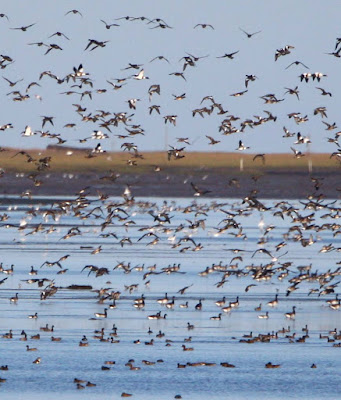Please remember! We ask that people do not visit the Reserve particularly if you have to travel. All car parks on Holy Island are closed to visitors until government restrictions are lifted. Many residents on Holy island fall into the vulnerable category. Please adhere to these guidelines for the health and safety of yourself and others during this time.
Once the last of the Terns and their newly fledged chicks have begun the epic migration back to their wintering grounds and the cacophony of calls and screeches of young Terns begging the parents incessantly for food ebbs away there is a brief pause. Then, come the last week of August the first of the wildfowl appear. At first, it’s just a trickle (usually failed breeders) but by late September numbers are still building and the trickle has become a full on flood. Many of the wildfowl species that winter at Lindisfarne National Nature Reserve have bred in the high arctic and migrate to the site, fleeing the brutal winters in the desolate tundra for an area rich in food that will remain mild and ice free through much of the winter.
 |
| Large numbers of wildfowl use the Reserve every winter ©JJD |
When people think of Lindisfarne in winter, most people associate it with Geese, and with large flocks moving to and from the Reserve on a daily basis, it is definitely an astounding sight to behold. But there is another species that descends on the Reserve in their thousands and in fact number make up more than a third of all birds wintering at Lindisfarne National Nature Reserve. That species is the Eurasian Wigeon.
 |
| Male and females surfing the waves ©JJD |
Eurasian Wigeon are a dabbling duck, meaning that they
generally feed on the surface and won’t dive like some other duck species. When
feeding they will skim the surface of the water for seeds, roots and leaves and
will, when the tide allows, feed on the important eel grass beds that are found
on the Reserve. There is a small breeding population in Scotland but the
majority of wintering Wigeon in the UK migrate from Iceland and Scandinavia.
As with most ducks the male has the more colourful plumage with the female a dull grey-brown colour. The male sports a rusty red head with a buff coloured crown, pinkish breast and a mottled grey body. The bills of both male and female are a greyish blue with a black nib. They can be seen in large flocks around the Reserve, with the diagnostic whistle of the drake carrying across the vast intertidal area on a calm winters morning.
As with most ducks the male has the more colourful plumage with the female a dull grey-brown colour. The male sports a rusty red head with a buff coloured crown, pinkish breast and a mottled grey body. The bills of both male and female are a greyish blue with a black nib. They can be seen in large flocks around the Reserve, with the diagnostic whistle of the drake carrying across the vast intertidal area on a calm winters morning.
 |
| Stunning - drake Wigeon ©JJD |
To monitor numbers using the Reserve monthly WeBS counts
have been carried out over many years and the data shared with the British
Trust for Ornithology (BTO). This data has shown that internationally important
numbers use the Reserve during winter. In fact, this winter just gone, 23,000
birds were counted on the Reserve, the highest number in 20 years. Wigeon are
one of the several important species of wintering birds that form the
Lindisfarne SPA (Special Protection Area); a designation that ensures the
safeguarding of habitats that support these wintering species. With numbers
utilising the Reserve in winter increasing, Wigeon are a good news story, when
so many other species are declining.
 |
| Large flocks can be seen on the Reserve ©JJD
|

No comments:
Post a Comment